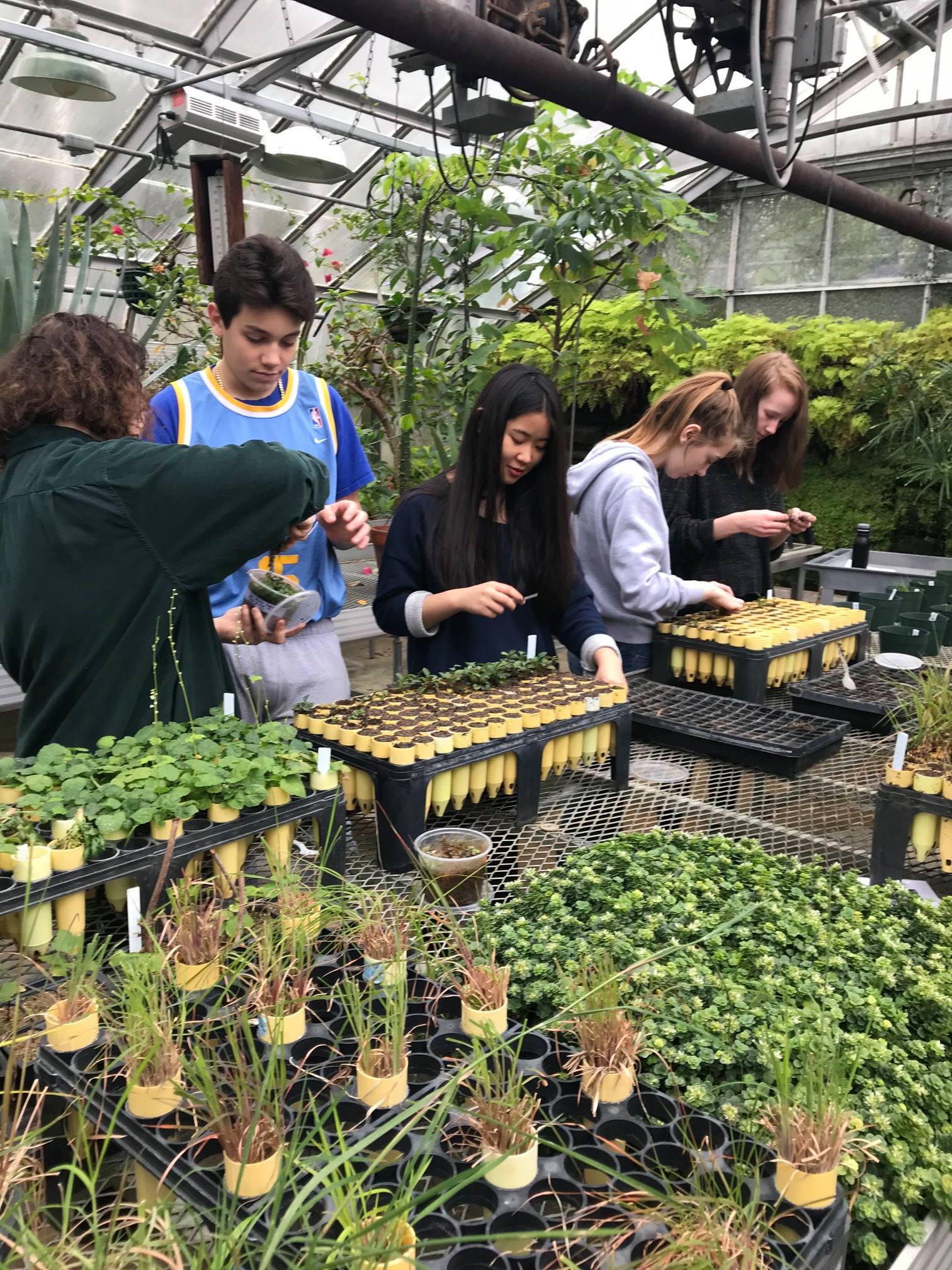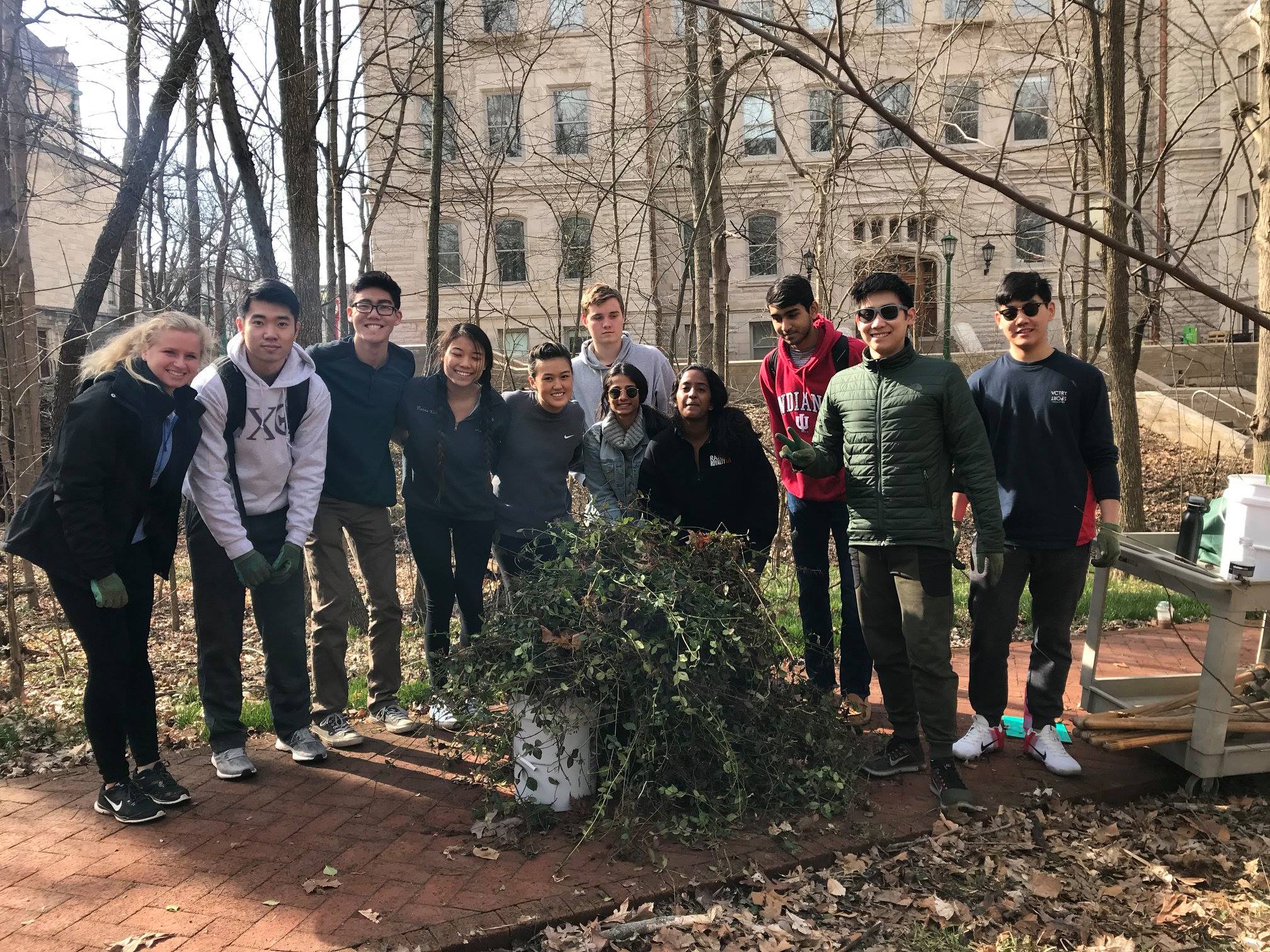Dunn's Woods
A modest forest stands at the green heart of Indiana University’s 2000-acre campus. Purchased in 1883 from the Dunn family, Dunn’s Woods was originally part of the Dunn family farm. Photographs from the turn of the 20th Century show Dunn’s Woods as a lawn with scattered trees and no underbrush. Combined with the sloping and rolling terrain that would have been unsuitable for row crops, this suggests prior use as a hog and cattle pasture. Early buildings formed a crescent around the wooded quadrangle, and the entire area, known as the Old Crescent, earned designation in the National Register of Historic Places in 1980.
David Starr Jordan, who served on the biology faculty before his selection as IU president in 1885, remarked to President Lemuel Moss as the Dunn’s Woods property was acquired: "I am glad to hear of the general brightness of the prospects of the institution. ... The location is certainly better among those great maples. I hope that you will let none be cut down, except when their removal is absolutely necessary." So began an unbroken tradition of respect and reverence for the trees and the landscape of Dunn's Woods that has continued to the present.
In 2010, our team began working to document the cultural and land use history of the woods. This knowledge, in combination with our ecological research, is essential to a full understanding of the diverse forces that have shaped this special place and to our efforts to control the invasion of Purple Wintercreeper (Euonymus fortunei) and other exotic invasive plants, to promote native flora (including perennial wildflowers), and to educate all about this iconic example of Midwestern forest biodiversity at the heart of a great public university.
Latimer Woods
Like Dunn’s Woods, Latimer Woods was part of a family farm for generations. Mr. Hugh Latimer and his family dedicated the ~ten-acre woodland to the Bloomington Community Foundation in 1999, and the City of Bloomington Parks and Recreation Department maintains the woodland as part of its parks and trails system.
Read more about the Woodland Campus
Education
We engage in service-learning partnerships with Indiana University courses from diverse disciplines, including History and Philosophy of Science; Biology; Public and Environmental Affairs, Recreation, Park and Tourism Studies; and Music. Service-learning activities include:
- Learning about exotic invasive plant species and helping to conduct exotic plant pulls in the woods
- Surveys of archival records and photographs, creation of podcasts, and development of recommendations to enhance the experience of visitor's to the woods
- Conducting interviews, shooting footage, and creating short films on restoration activities in the woods
- Mapping of exotic invasive species and quantifying native spring wildflower abundance and composition in the woods
- Hosting community-wide events (on topics such as biodiversity, native and invasive species, forest food webs) and creating educational activities for the events
- Creating outreach materials including blogs, brochures, handouts, social media materials, and lessons for children
Course Partnerships
- BIOL L326, Biodiverse City (Heather Reynolds)
- SPH R410, Event Planning and Program Development (Annie Eakin)
- HPS X223, Landscapes of Learning: Environmental History of IU Bloomington (Jim Capshew)
- COLL T200, Living a Sustainable Life (Christine Barbour)
- BIOL L350, Environmental Biology (Peggy Schultz)
- MUS Z120, Music in Multimedia (Kristen Bellisario)
- SPEA E527, Applied Ecology (Mikala Schmitt-Harsh)
- Community Service Writing (Joan Linton)
- SPH O340, Interpretation and Tour Guiding (Brian Forist)
We also teach hands-on ecology lessons to elementary and high school students. Lessons focus on concepts such as native and invasive plants, ecosystem services, and food webs. We conduct restoration sessions with local schools as well. For more information, contact graduate intern Savannah Bennett at savabenn@indiana.edu.
Outreach
We have created a diversity of outreach products to help reconnect people to local woodlands. We have also presented our work to a wide variety of audiences.
Outreach Products:
We derive many benefits from our urban woodlands, including air quality regulation, flood regulation, climate regulation, aesthetic beauty, and recreational and educational space.
Dunn's Woods
Size: ~10 acres
Age: 100+ years
Location: Bloomington, Indiana - Heart of the Old Crescent at Indiana University’s Bloomington Campus
Canopy: Deciduous, primarily Beech-Maple
Native Wildflowers: Trout Lily, Toothwort, Wild Ginger, Spring Beauty, Trillium, Mayapple
Animals: Cooper’s Hawks, hummingbirds, box turtles, rabbits, squirrels, butterflies
Threats: Exotic invasive plants, especially Purple Wintercreeper; windfall gaps from severe storms
Latimer Woods
Size: ~10 acres
Age: 100+ years
Location: Bloomington, Indiana - South side of College Mall, accessed off S Clarizz Blvd or East Stratum Way
Canopy: Deciduous, primarily Beech-Maple
Native Wildflowers: Trout Lily, Toothwort, Spring Beauty, Trillium, Mayapple, Dutchman’s Breeches, Rue Anemone, Jack-in-the-Pulpit
Animals: Deer, Woodpeckers (Pileated, Downy, Red-bellied, Yellow-bellied Sapsuckers), Northern Flickers, Northern Cardinals, Carolina Wrens, Carolina Chickadees, Brown Thrashers, White-breasted Nuthatches, Eastern Towhees, rabbits, squirrels, butterflies, patent-leather beetles
Threats: Exotic invasive plants, especially Purple Wintercreeper, Wild Celandine, and Garlic Mustard
Meet the Plants
We are planting the following native woodland species into Dunn's Woods to restore its beauty, biological diversity, and ecological services. Native plants are adapted to local soils, climate and biota, and are part of an interdependent web of life that also includes animals and microbes. We derive many benefits from Dunn's Woods, including air quality regulation, flood regulation, climate regulation, aesthetic beauty, and recreational and educational space.
Our native plant seed is collected locally or ordered from Indiana genotype suppliers.
- American Bellflower
- Blue Flag Iris
- Bottlebrush Grass
- Brown Fox Sedge
- Bushy Seedbox
- Calico Aster
- Calico Beartongue
- Cardinal Flower
- Christmas Fern
- Cutleaf Coneflower
- Downy Skullcap
- Dwarf Crested Iris
- False Sunflower
- Fragrant Sumac
- Frank's Sedge
- Fringed Sedge
- Golden Ragwort
- Gray's Sedge
- Great Blue Lobelia
- Hairy Woodland Brome
- Hairy Wood Mint
- Hop Sedge
- Joe-Pye Weed
- Late Figwort
- Mistflower
- Ninebark
- Orange Jewelweed
- Panicled Aster
- Smooth Wild Petunia
- Spicebush
- Stiff Sunflower
- Stout Wood Reed
- Thimbleweed
- White Snakeroot
- Wild Senna
- Wild Stonecrop
- Wild Ginger
- Wingstem
Research
Dunn’s and Latimer Woods are active sites for research by faculty, students, and community partners. Areas of study include methods of Purple Wintercreeper control and native species restoration; the effects of deer and small mammal herbivores on native vs. exotic plants; plant-soil-microbe associations; abundance and composition of butterflies, moths and other insects in the woodlands; and plant species traits such as drought tolerance. Findings to date include:
- Both hand pulling and herbicide application are effective at removing Purple Wintercreeper and permitting re-establishment of native species from seed or transplanted seedlings. Hand pulling is most practical in small areas, however, as it requires large inputs of time and labor.
- Native plants can be slow to recover and are vulnerable to herbivory by rabbits and other animals
- Soil underneath Purple Wintercreeper has a unique microbial composition and promotes its growth
- Abundance and diversity of butterflies, moths and other insects in these woodlands is currently very low
- Purple Wintercreeper is more tolerant of drought stress than common native species.
Presentations
Bauer JT, Rutherford WA, Stoops RE, Reynolds HL. (2013) Euonymus fortunei: Back-seat driver of environmental change? Poster, Ecological Society of America Annual Meeting, Minneapolis, MN.
O’Neill M, Bauer JT, Reynolds HL. (2013) Invasive plant and herbicide legacy effects limit native plant recruitment from seed in an urban woodland. Poster, Indiana Academy of Sciences Annual Meeting, Indianapolis, IN.
Bauer JT, Rutherford WA, Stoops RE, Reynolds HL. (2013) Euonymus fortunei: driver or passenger of environmental change? Talk, Indiana Academy of Sciences Annual Meeting, Indianapolis, IN.
Bauer JT, Rutherford WA, Stoops RE, Reynolds HL. (2013) Impacts and management of Euonymus fortunei (Purple Wintercreeper). Poster; Science, Practice, & Art of Restoring Native Ecosystems Conference, East Lansing, MI.
Hobbs FC, Allaby E, Shanno-Firestone S, Swedo B, Gube J, Reynolds H. (2012) Wild ginger (Asarum canadense) associates with a unique soil bacterial community in a south-central Indiana woodland fragment. Poster, Indiana Academy of Science Annual Meeting, Lafayette, IN.
Rutherford WA, Bauer JT, Stoops RE, Reynolds HL. (2011). Consequences of Euonymus fortunei invasion for native plants and herbivores and initial results of management efforts. Poster, Indiana Academy of Science Annual Meeting, Indianapolis, IN.
Publications
Smith L M and H L Reynolds. 2012. Positive plant-soil feedback may drive dominance of a woodland invader, Euonymus fortunei. Plant Ecology 213:853-860.
Swedo BL, C Glinka, DR Rollo and HL Reynolds. 2008. Soil bacterial community structure under exotic versus native understory forbs in a woodland remnant in Indiana. Proceedings of the Indiana Academy of Sciences 117:7-15.



